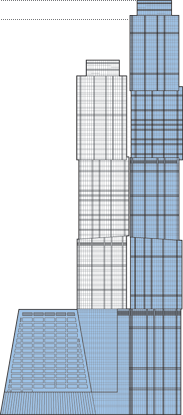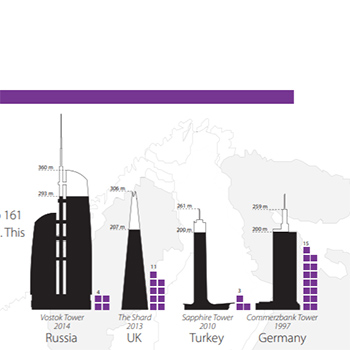Filter by
You must be a CTBUH Member to view this resource.

Capital City Moscow Tower
One Capital City
Building
Completed
2010
Residential
All-Concrete
301.8 m / 990 ft
76
6
8
7 m/s
You must be a CTBUH Member to view this resource.
You must be a CTBUH Member to view this resource.
Proposed
Construction Start
Completed
Usually involved in the front end design, with a "typical" condition being that of a leadership role through either Schematic Design or Design Development, and then a monitoring role through the CD and CA phases.
The Design Engineer is usually involved in the front end design, typically taking the leadership role in the Schematic Design and Design Development, and then a monitoring role through the CD and CA phases.
The Design Engineer is usually involved in the front end design, typically taking the leadership role in the Schematic Design and Design Development, and then a monitoring role through the CD and CA phases.
Material Supplier refers to organizations which supplied significant systems/materials for a building project (e.g. elevator suppliers, facade suppliers, etc).
You must be a CTBUH Member to view this resource.
Usually involved in the front end design, with a "typical" condition being that of a leadership role through either Schematic Design or Design Development, and then a monitoring role through the CD and CA phases.
The Design Engineer is usually involved in the front end design, typically taking the leadership role in the Schematic Design and Design Development, and then a monitoring role through the CD and CA phases.
The Design Engineer is usually involved in the front end design, typically taking the leadership role in the Schematic Design and Design Development, and then a monitoring role through the CD and CA phases.
The main contractor is the supervisory contractor of all construction work on a project, management of sub-contractors and vendors, etc. May be referred to as "Construction Manager," however, for consistency CTBUH uses the term "Main Contractor" exclusively.
Other Consultant refers to other organizations which provided significant consultation services for a building project (e.g. wind consultants, environmental consultants, fire and life safety consultants, etc).
These are firms that consult on the design of a building's façade. May often be referred to as "Cladding," "Envelope," "Exterior Wall," or "Curtain Wall" Consultant, however, for consistency CTBUH uses the term "Façade Consultant" exclusively.
Material Supplier refers to organizations which supplied significant systems/materials for a building project (e.g. elevator suppliers, facade suppliers, etc).
1 September 2011 - Event
22 October 2008 - Conference

01 June 2013
CTBUH Research
There are currently 109 skyscrapers over 150 meters in Europe. This number is set to jump to 161 by the end of 2015, meaning that...
Capital City is comprised of two residential towers, individually named after two major Russian cities, Moscow Tower (the taller of the pair) and St. Petersburg Tower. A 17-story business center is housed in the complex. The towers’ form creates the visual effect of a series of stacked boxes offset from one another. This effect is achieved through a slight cantilever on only two façades of each vertical segment, and thus does not compromise the continuity of the towers’ main vertical structure. A mechanical floor demarcates each 15-floor segment and integrates the structural system. The Moscow Tower contains five such segments while the St. Petersburg Tower contains four.
Providing large, open living spaces with full-height glazing led to a structural solution that combines a minimal building core with a mega-column structure to achieve enhanced structural efficiency. Eight mega-columns carry loads for each tower segment. At each mechanical floor, the vertical load is transferred from the corner and central columns to the mega-columns through a perimeter belt truss.

01 June 2013
CTBUH Research
There are currently 109 skyscrapers over 150 meters in Europe. This number is set to jump to 161 by the end of 2015, meaning that...

13 April 2011
CTBUH Research
Tall buildings are spreading across the globe at an ever-increasing rate. This study demonstrates the relationship between population and tall buildings across those countries and...

06 April 2011
Yuri Starodubtsev, Capital Group; Joey Myers & Larry Goetz, NBBJ
As a pioneering project in Moscow, Capital City has forged many new pathways for the city’s real estate and construction industries. Through its integrated design...

31 December 2010
CTBUH Research
In a year dominated by news coverage of the new “World’s Tallest Building” – Burj Khalifa, Dubai – one may be surprised to learn that,...
2 September 2011
CTBUH Chairman Professor Sang Dae Kim held tall building lectures in Thailand, Vietnam, Indonesia and Russia with the dual purpose of promoting CTBUH and the 2011 Seoul Conference.
Subscribe below to receive periodic updates from CTBUH on the latest Tall Building and Urban news and CTBUH initiatives, including our monthly newsletter. Fields with a red asterisk (*) next to them are required.
View our privacy policy